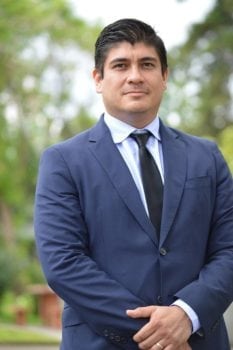The Evolution of Costa Rica's Government
From as far back as 10,000 B.C.E.
people who made their way across the frozen land bridge connecting Asia and
North America and down the North American continent inhabited modern day Costa
Rican land. Without a significant
unifying power imposing itself in the area for thousands of years, distinct
cultural groups essentially governed themselves, led by tribal chiefs called “caciques”.
 |
| Tupac Amaru II, an Andean cacique who led a massive rebellion in 1781 |
When the Spanish arrived on Costa Rican land in the early 16th century, widespread disease and advanced, lethal weaponry enabled the Spaniards to force natives under the rule of the Captaincy General of Guatemala (or Kingdom of Guatemala), a province of New Spain that included the modern day countries of Nicaragua, Honduras, El Salvador, Belize, Guatemala, and the Mexican state of Chiapas, for the next 300 years.
 |
| The flag of New Spain |
Costa
Rica achieved independence from Spanish rule in the 1810-1821 Mexican War of Independence,
subsequently becoming part of the Federal Republic of Central America. To commemorate the victory, the country began
printing coins highlighting important national events. In a 2016 article published in the Costa Rican
journal Reflexiones entitled From the genie to the indians: medals and coins proclaimed new governments in costarica (1821-1850), authors Zamora and Hidalgo argue,
“In addition to being a method of payment, the coins served the purpose of illustrating forms of government and governmental priorities through their imprinted symbols, and given the shortage or lack of newspapers and the high rate of illiteracy, the figures printed on the pieces of metal were intended for the masses.”Fifteen years later, in 1838, Costa Rica officially gained full independence. In 1869, Costa Rica established a democratic government and after the Costa Rican Civil War of 1948, the government drafted a new constitution modeled after that of the United States. However, very much unlike the United States, Costa Rica abolished its own military.
Today,
Costa Rica’s government is regarded as a democratic republic. The governmental framework grants citizens
and foreigners equality before the law, the right to own property, the right of
petition and assembly, freedom of speech, and the right to habeas corpus. The index of economic
freedom, generated from an evaluation of ten freedoms based on the amount
of economic autonomy from government intervention, rates Costa Rica a
65.6/100. Like the United States, the structure of the Costa
Rican government is divided into independent executive, legislative, and
judicial branches. The executive branch
consists of a president, two vice presidents, and a cabinet of 17 members
called the Council of Government (or Consejo de Gobierno). The legislative branch consists of a unicameral
body composed of 57 members elected by proportional representation. And the judicial Branch contains 24 judges, a
special electoral tribunal, and an independent body that oversees each election
called the Supreme Elections Tribunal. Governors
oversee the nation’s seven provinces of Alajuela, Cartago, Guanacaste, Heredia,
Limón, Puntarenas, and San José. Provinces are divided into 83 counties,
which are then further divided into a total of 463 districts overseen by
municipal councils.
 |
| Current President Carlos Andrés Alvarado Quesada |
In
Costa Rican history, elected presidents have belonged to ten distinct political
parties. Two have held the most power in
government since 1949: The National Liberation Party
(currently with 17 representatives in the legislature) and the Social Christian Unity
Party (currently with 9 representatives in the legislature). Current leadership
includes president Carlos
Andrés Alvarado Quesada of the Citizens’ Action party (currently
with 10 representatives in the legislature) and at 38 the youngest president in
modern Costa Rican history, vice-president Epsy Campbell Barr
(the first Afro-Costa Rican to serve as vice-president and first woman of
African descent to hold a vice-presidential position anywhere in the
continental Americas), vice president Marvin Rodriguez Cordero, president of
the legislative assembly Carolina Hidalgo Herrera and president of the court
Carlos Chinchilla Sandí. Despite the
recent 2018
elections showcasing national unity, current
problems facing the country include environmental
conservation policy, prison system reform, addressing the fiscal deficit, and
human trafficking. Not to mention Costa
Rica’s upcoming win-or-be-eliminated soccer match with heavyweight Brazil in
the group stage of the World Cup!





Comments
Post a Comment